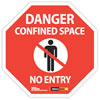Working safely around confined spaces
Employers are responsible for managing the confined space hazards in a workplace. If you are a worker, there are also steps you can take to protect yourself and others from confined space hazards:
-
1
Recognize confined spaces
-
2
Know the hazards
See Determine the hazard for each space in the Managing confined spaces.
-
3
Know what to do about confined spaces
What to do about confined spaces
If you see a confined space — or a space you think might be a confined space — stay away. It could be dangerous for you to enter. You may not be able to tell if the air inside is safe to breathe.
You should also stay away from entrances or openings to confined spaces. If a confined space has toxic gases or not enough oxygen, even putting your head inside the space or near the opening could be dangerous.
Your employer should have signs posted around the workplace identifying all confined spaces. These signs are there to stop people from entering confined spaces that may be dangerous because of toxic gases or other hazards.
In many cases, confined spaces will be locked or secured. If you see a fence, barrier, or guardrail, it's probably there for a reason. If you think you need to enter a secured space, first ask your employer or supervisor if it's safe.

If someone enters a confined space and loses consciousness or is unable to move, don't rush into the space to try and rescue the person. The confined space may contain toxic gases that can knock you out too, or kill you in seconds.
Do not enter any confined space unless you can say "yes" to all of the following items:
- You have been trained to enter and work in confined spaces.
- Your employer has a confined spaces program and a rescue plan specific to your workplace.
- Equipment is available to safely enter the space and rescue injured workers in an emergency.
- Machinery has been locked out and pipes have been isolated, where necessary.
- The atmosphere in the confined space has been tested to ensure it's safe to enter.
- The space is properly ventilated.
- A designated standby person is stationed at or near the entrance to the confined space.
Always be sure to tell your employer if you see a possible confined space.
Look out for possible confined spaces in your workplace. There could be confined spaces that your employer or supervisor doesn't know about.
Don't ignore a possible confined space. It doesn't hurt to ask about it. Alerting your employer or supervisor to spaces they may not already know about could save someone's life.



